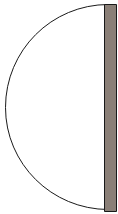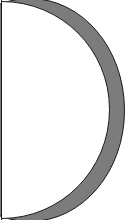
The focal length of the objective of a terrestrial telescope is 80 cm and it is adjusted for parallel rays, then its magnifying power is 20. If the focal length of erecting lens is 20 cm, then full length of telescope will be:
Answer
552.3k+ views
Hint: In this question, we will use the relation between magnification and the given focal lengths. Further, by solving for the length of the telescope, we will get the required result. Also, we will discuss the basics of mirror, lens and types of lenses, for our better understanding.
Formula used:
$m = \dfrac{{{f_0}}}{{{f_e}}}$
$L = {f_0} + {f_e} + 4f$
Complete answer:
As we know, the magnification of a lens is the measure of the degree of convergence or divergence of light rays falling on the lens.
Here, mathematically, magnification is given as:
$m = \dfrac{{{f_0}}}{{{f_e}}}$
Substituting the given values, we get:
$\eqalign{& 20 = \dfrac{{80}}{{{f_e}}} \cr
& \Rightarrow {f_e} = 4cm \cr} $
Therefore, length of terrestrial telescope will be given as:
$L = {f_0} + {f_e} + 4f$
Now, by substituting the given values, we get:
$\eqalign{& L = 80 + 4 + 4 \times 20 \cr
& \therefore L = 164cm \cr} $
Therefore, we get the required result, which gives us the terrestrial length of the given telescope.
Additional information:
As we know a mirror is defined as a device that contains a surface, which is mainly used to reflect light. As mirrors do not usually absorb much light, most of the light is redirected. The mirror and the object's overall quality is generally preserved in the new image.
In the given figure, the shaded portion is not used to reflect light.

convex mirror

concave mirror.
Now, as we know that a lens is defined as a transmissive optical device that is used to focus or disperse beams of light by the means of refraction. For example- a lens can focus light to form an image, unlike a prism, which refracts light without focusing.
Here, there are two types of lenses, first one is a simple lens and second one is a compound lens. Here, as we know that a simple lens includes only a single piece of transparent material, whereas a compound lens consist of several simple lenses arranged along with a common axis
As we know that lenses are of two types.
This classification of lenses depends on how the light rays bend when they pass through the lens:
Convex Lens also called Converging lens:
As we know, that convex lens is thick in the middle and they are thinner at the edges. Here, we also know that a convex lens is also called the converging lens; this is because the light rays bend inwards and converge at a point which is known as focal length.
Concave Lens also called Diverging lens:
Here, we define a concave lens which is flat in the middle and thicker at the edges. Also, a concave lens is known as a diverging lens as it bends the parallel light rays outward and diverges the light rays at the focal point.
Note:
We should remember that a mirror will have only one focal point, which is in front of the mirror. We should note that compound lenses are constructed from a combination of different simple lenses. The lens which is used to build a compound lens may have different refractive indices and other properties.
Formula used:
$m = \dfrac{{{f_0}}}{{{f_e}}}$
$L = {f_0} + {f_e} + 4f$
Complete answer:
As we know, the magnification of a lens is the measure of the degree of convergence or divergence of light rays falling on the lens.
Here, mathematically, magnification is given as:
$m = \dfrac{{{f_0}}}{{{f_e}}}$
Substituting the given values, we get:
$\eqalign{& 20 = \dfrac{{80}}{{{f_e}}} \cr
& \Rightarrow {f_e} = 4cm \cr} $
Therefore, length of terrestrial telescope will be given as:
$L = {f_0} + {f_e} + 4f$
Now, by substituting the given values, we get:
$\eqalign{& L = 80 + 4 + 4 \times 20 \cr
& \therefore L = 164cm \cr} $
Therefore, we get the required result, which gives us the terrestrial length of the given telescope.
Additional information:
As we know a mirror is defined as a device that contains a surface, which is mainly used to reflect light. As mirrors do not usually absorb much light, most of the light is redirected. The mirror and the object's overall quality is generally preserved in the new image.
In the given figure, the shaded portion is not used to reflect light.

convex mirror

concave mirror.
Now, as we know that a lens is defined as a transmissive optical device that is used to focus or disperse beams of light by the means of refraction. For example- a lens can focus light to form an image, unlike a prism, which refracts light without focusing.
Here, there are two types of lenses, first one is a simple lens and second one is a compound lens. Here, as we know that a simple lens includes only a single piece of transparent material, whereas a compound lens consist of several simple lenses arranged along with a common axis
As we know that lenses are of two types.
This classification of lenses depends on how the light rays bend when they pass through the lens:
Convex Lens also called Converging lens:
As we know, that convex lens is thick in the middle and they are thinner at the edges. Here, we also know that a convex lens is also called the converging lens; this is because the light rays bend inwards and converge at a point which is known as focal length.
Concave Lens also called Diverging lens:
Here, we define a concave lens which is flat in the middle and thicker at the edges. Also, a concave lens is known as a diverging lens as it bends the parallel light rays outward and diverges the light rays at the focal point.
Note:
We should remember that a mirror will have only one focal point, which is in front of the mirror. We should note that compound lenses are constructed from a combination of different simple lenses. The lens which is used to build a compound lens may have different refractive indices and other properties.
Recently Updated Pages
Master Class 12 Economics: Engaging Questions & Answers for Success

Master Class 12 Maths: Engaging Questions & Answers for Success

Master Class 12 Biology: Engaging Questions & Answers for Success

Master Class 12 Physics: Engaging Questions & Answers for Success

Basicity of sulphurous acid and sulphuric acid are

Master Class 12 Business Studies: Engaging Questions & Answers for Success

Trending doubts
What are the major means of transport Explain each class 12 social science CBSE

Which are the Top 10 Largest Countries of the World?

Draw a labelled sketch of the human eye class 12 physics CBSE

How much time does it take to bleed after eating p class 12 biology CBSE

Explain sex determination in humans with line diag class 12 biology CBSE

Differentiate between homogeneous and heterogeneous class 12 chemistry CBSE




